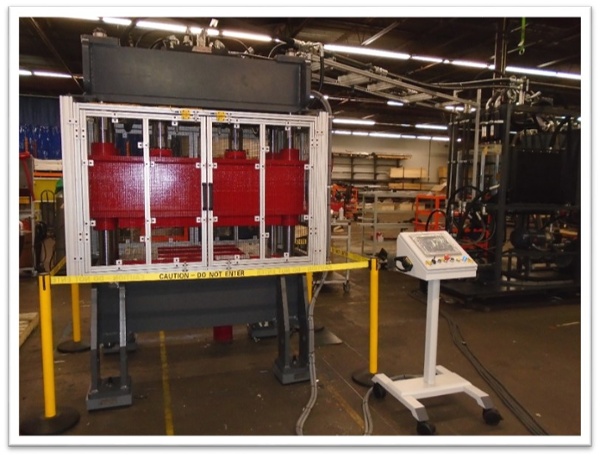Why It Matters for Data Centers
-
Precise Fit: Factory tolerances as tight as ±0.005” ensure exact alignment with rack mounting points.
-
Repeatable Quality: Each piece is identical, eliminating site-to-site variation and reducing rework.
-
Integrated Design: In-line punching, slotting, and embossing reduce secondary machining steps.
-
Efficient Production: Roll forming yields only 0.5-3% material scrap – a critical advantage when working with pricey copper.
- Installation Speed: Bolt-in, pre-punched designs cut installation time by up to 75% and accelerate project turnover.
By using pre-engineered parts instead of field-modified components, contractors can standardize installation procedures and simplify documentation for inspection. This ensures every grounding connection meets NEC and TIA compliance requirements without delay.
Copper and Steel in Action
Roll forming leverages the natural strengths of both copper and steel, making it ideal for high-density electrical environments where performance, weight, and space efficiency must align.
Copper Busbars: Low Impedance and High Reliability
Copper’s extremely low resistivity makes it the preferred conductor for high-current distribution. Roll forming maximizes its advantages by producing uniform, high-precision profiles with minimal springback, ensuring an exact fit and consistent performance.
Unlike field-bent bars that develop hardened stress points, roll-formed copper maintains structural integrity throughout its length. For harsh environments, tin-plated copper provides an additional layer of protection against oxidation and galvanic corrosion, preserving low contact resistance for decades.
Each connection point is engineered to maintain a sub-milliohm path, supporting efficient power delivery while minimizing heat buildup. For facilities operating at 20-40 kW per rack, even small resistance reductions can lead to measurable improvements in energy efficiency and thermal management.
Steel Grounding Channels: Structure and Shielding in One Profile
Galvanized steel channels are a cornerstone of grounding infrastructure. They provide mechanical strength, EMI/RFI shielding, and continuous electrical continuity in one compact profile.
Because roll forming maintains tight cross-sectional tolerances, channels attach flush and straight, eliminating the gaps that cause electromagnetic leakage or grounding failure. Integrated punching allows fast bonding without secondary drilling, and slim, custom designs preserve airflow through cable pathways.
Example: A hat-channel stiffener can add 20-30% structural load capacity to an existing rack without blocking cooling airflow or requiring welding, making it ideal for retrofits or seismic reinforcements.
Multifunction Grounding Channel Benefits
|
Function |
Benefit |
Uses |
|
Structural Support |
High strength-to-weight ratio supports heavy loads efficiently |
Equipment mounting, framing, and overhead trays |
|
EMI/RFI Shielding |
Continuous uniform profiles prevent interference gaps |
Shielding frames and containment zones |
|
Integrated Grounding |
Pre-punched holes align with rack standards for consistent bonds |
Bolt-in connections, torque-verified grounding |
|
Airflow Optimization |
Slim profiles maintain critical cooling pathways |
Cable channels, hot/cold aisle design |
|
Retrofit Compatibility |
Hat and box channels can reinforce legacy racks |
Seismic upgrades and capacity expansions |
By combining multiple functions into one engineered component, roll-formed channels reduce part counts, simplify installation, and extend the life of your infrastructure.
Designing for Performance and Compliance
Early collaboration between design engineers and roll forming specialists is the key to optimal performance and manufacturing efficiency. Consider these factors when designing busbars or grounding channels:
- Material Selection: Match material thickness and coating to current-carrying needs and environmental exposure. Use galvanized or tin-plated metals to resist oxidation.
- Geometry Optimization: Maintain bend radii 1.5-2× the material thickness, and flange lengths ≥3× the gauge. Add ribs or returns to prevent deformation.
- In-Line Features: Plan all mounting holes, slots, and part IDs during design. Integrated embossing improves traceability and quality control.
- Thermal Management: Optimize for airflow and minimal thermal rise during continuous high-current operation.
These considerations ensure a balance of electrical performance, manufacturability, and long-term mechanical stability.
Partnering for Proven ResultsNot all roll formers deliver the same level of precision, reliability, or supply chain coordination. Choosing the right partner ensures your infrastructure performs flawlessly and arrives when you need it. Dahlstrom Roll Form brings over 120 years of manufacturing experience to critical industries, combining engineering collaboration with dependable production quality.
By partnering with Dahlstrom, you gain a manufacturer who understands not just how to form metal but how to engineer for reliability, code compliance, and system longevity. |
Build Code-Ready Infrastructure With Confidence
Grounding reliability is more than a compliance requirement; it’s the foundation of every high-performance data center. As rack densities rise and standards tighten, roll-formed busbars and grounding channels provide the consistency and precision that field fabrication can’t match.
Ready to eliminate grounding headaches and streamline your next installation?
Visit our online Product Catalog to explore how bolt-in, code-ready solutions can help you build stronger, safer, and smarter data center infrastructure.




.jpg)

